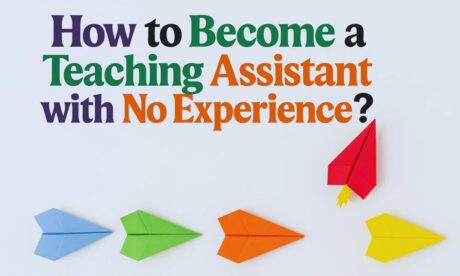Have you ever seen someone helping the teacher in class? That’s a teaching assistant, often called a TA. The role of a teaching assistant is to make learning easier for everyone. So, what is teaching assistant responsibilities, exactly?
A TA helps pupils understand lessons and stay on track. They might read with small groups or help with writing and maths. Some TAs also support children with special educational needs (SEND), so no one feels left out. Now, here’s the thing — TAs do much more than help with schoolwork. They’re the steady hands that keep the classroom running smoothly. When things get busy, they help pupils stay focused and make sure everyone feels safe and supported. On top of that, they follow school rules and report any concerns to the Designated Safeguarding Lead. Their work helps teachers teach and pupils learn without any bumps along the way.
In this post, we’ll dig a little deeper into what does a TA do day to day. Also, we’ll explore the core TA duties UK classrooms depend on and uncover the real role of a teaching assistant in shaping confident, capable learners.
1) Supporting Classroom Learning

The most important part of a teaching assistant’s job is helping in the classroom so pupils can meet their learning goals. TAs often break instructions into simple steps so tasks feel easier to manage. They model examples to show what good work looks like. When pupils need extra help, TAs offer one-to-one support or guide small groups. They also use pictures and word lists to make learning easier and help pupils understand hard ideas.
2) Assisting the Teacher with Lessons
Teaching Assistants also help teachers run lessons smoothly. For the classroom setup, they get books, devices, and other materials ready. They also help set up things like putting up displays or getting activities ready. During the lesson, they help with warm-ups, group work, and finishing tasks. Their help keeps lessons on track; thus, teaching support gives teachers more time to teach.
3) Helping Children with Special Educational Needs (SEN)
Another key role of teaching assistants (TAs) is SEN support. They help children take part in lessons and feel included in an inclusive classroom. TAs follow specific strategies and watch how the child responds to see what works best. They often use plans like an EHCP (Education, Health and Care Plan) to guide their support.
Main Jobs of a SEN TA
1. Using Individual Support Plans
TAs follow the child’s plan carefully:
- EHCP / IEP: Know the child’s targets and use them all day.
- Structured Support: Tools to help learning and behaviour:
- Visual Schedules: Show the day’s activities to reduce worry.
- Timers: Help the child know how long a task will last.
- Movement Breaks: Short walks or exercises to help focus.
2. Adapting Learning Tasks
TAs make tasks easier so children can join in:
- Task Adaptation: Break tasks into small steps or simplify instructions.
- Resources: Use special tools like slanted boards, tactile materials, or headphones to support learning.
3. Watching and Recording Progress
TAs also notice how well the child is doing:
- Notes on Progress: Write short notes about engagement, targets, and challenges.
- Reporting: Share progress with the teacher and SENCO. This helps adjust the plan so SEN support stays effective.
4) Managing Classroom Behaviour
Teaching Assistants help with behaviour management in class. For example, they use positive routines, like the same steps for arriving, moving between tasks, or tidying up. Next, they stay close to pupils and give calm reminders to help them focus. They praise students for good behaviour. Also, they tell the teacher or senior staff about serious concerns about classroom rules. It helps to ensure all interactions are calm and respectful.
5) Supervising Children Safely
Teaching Assistants play an important role in pupil supervision. They help make sure the school is a safe place. Everyone can learn and play without worry.
TAs watch children all day. This includes lessons, group work, breaks, and lunch. They also help during school trips. They watch children during transitions, like moving between classrooms or going to the playground. This keeps children safe at every part of the school day. TAs do headcounts to check that all pupils are present. They follow risk assessments for activities and trips. This helps spot dangers. It also prevents accidents before they happen, as keeping children safe is always the top priority. Moreover, TAs watch for signs of bullying, harm, or neglect to protect pupils’ mental health.
During these activities, TAs make sure the classroom and playground are safe for all.
6) Giving Feedback to Teachers
Imagine trying to keep track of 30 learners all at once! That’s where TAs shine. They are like the teacher’s extra eyes and ears. They watch and understand how each child is progressing.
TAs give quick, factual pupil progress feedback to the teacher. They note who grasped a tricky maths concept right away and who needs extra help. Also, they spot behaviour or well-being changes, like a quiet child or a friendship wobble. Besides, they write observation notes and keep intervention records. This can include reading logs or sheets to make sure every child gets help. Such teamwork between TAs and teachers helps every student succeed.
7) Supporting Social and Emotional Development
School isn’t just about academics; it’s about growing as a person. TAs play a big role in social and emotional learning and overall pupil wellbeing.
They encourage confidence by praising effort and celebrating small wins. They also help children navigate friendships and resolve minor conflicts. TAs help children manage their feelings using simple tools, like “now/next boards” or calm corners. If a child has serious worries, TAs tell the teacher or DSL. They always keep this information private.
This pastoral support helps children feel safe, understood, and ready to learn.
8) Preparing and Tidying Learning Spaces
TAs help keep the classroom ready for learning. They keep the room tidy, safe, and easy to move around in. They also check walkways, store equipment properly, and label all trays.
Another important task is updating displays to celebrate student work. This helps children feel calm and focused. Such good classroom organisation helps create a calm and welcoming learning environment. As a result, everyone can feel comfortable and enjoy their lessons.
9) Helping with Reading and Literacy Skills
TAs give important reading support to help children become confident readers. They run short phonics practice sessions, either in small groups or one-on-one. They also show children how to sound out and blend letters to read new words.
Furthermore, they track pages read and check fluency to help children build reading stamina. They praise the effort to make reading fun and encourage children to keep trying. This literacy support helps children enjoy reading and learn on their own.
10) Assisting with Admin and Everyday Tasks
TAs don’t just help with learning. They also do important school admin tasks that keep the classroom running smoothly. This lets teachers spend more time teaching.
- Handling Resources: TAs get materials ready for lessons. They photocopy worksheets or print posters when the teacher asks.
- Managing Paperwork: They help with TA paperwork, like preparing assessment packs or filling out simple logbooks to keep records updated.
- Communication Support: TAs help with routine parent messages. They always follow the teacher’s or the school office’s instructions.
- Classroom Logistics: They tidy the room, collect supplies, and make sure classroom resources are ready for the next lesson.
Actually, they are true multi-talented superstars!
What Teaching Assistants Are Not Responsible For
Teaching Assistants (TAs) play a big part in helping children learn, but they don’t replace teachers. It’s important to understand TA boundaries so everyone knows their role.
5 Things a Teaching Assistant Should Not Do
- Teach without guidance – A TA supports learning but doesn’t plan or lead full lessons unless directed by the teacher. Teaching decisions always belong to the teacher.
- Make safeguarding decisions alone – If a child shares something worrying, a TA must report it to the Designated Safeguarding Lead (DSL) — not handle it by themselves.
- Take full class responsibility – They should not manage the entire class alone unless they are trained and authorised, such as during HLTA cover under a teacher’s direction.
- Ignore behaviour or wellbeing issues – TAs shouldn’t overlook problems. They must share any behaviour, safety, or well-being concerns with the teacher right away, following school policy.
- Cross professional boundaries – TAs must keep a clear line between being friendly and being professional. They shouldn’t share personal contact details, gossip about pupils, or break TA boundaries.
If you’re thinking about becoming a TA or want to know what qualifications and skills you’ll need, it’s worth exploring the next step. The Requirements to Be a Teaching Assistant guide by Unified Course breaks down everything you should know — from training and experience to the personal qualities schools look for.
Skills That Make a Great Teaching Assistant
Being a great TA takes more than just helping in class. It’s about having the right mix of TA skills to support both teachers and pupils every day.
TAs need patience and empathy to understand how each child learns and feels. Good communication helps them work well with teachers, parents, and students. They also use strong organisational skills to keep lessons running smoothly and resources ready on time. Modern classrooms need some tech know-how, too! TAs often use basic IT tools like interactive whiteboards, printers, and learning apps.
Most importantly, every TA must have a strong safeguarding mindset. They know what to do if something seems wrong: notice, record, and report to keep every child safe.
Different Levels of Teaching Assistants (L1, L2, L3, HLTA)
Not all teaching assistants have the same role; their responsibilities vary with experience and training. In UK schools, there are several TA levels, each showing how much support and independence a TA can offer. From providing basic classroom help to leading lessons, every level plays an important part in helping children learn and thrive.
- Level 1 TAs give basic classroom help. They support the teacher by preparing materials, tidying up, and helping pupils stay on task.
- Level 2 TAs take on a bit more responsibility. They might work with small groups of children, helping them understand lessons or practise new skills.
- Level 3 TAs work more independently. They often support children with special educational needs (SEN) and run small intervention sessions to help pupils who need extra practice.
HLTAs (Higher Level Teaching Assistants) have the most responsibility. They can lead learning activities or even cover lessons when the teacher is away — always under the teacher’s direction.
Each level shows a step forward in skill, confidence, and the ability to make a real difference in pupils’ learning.
Key Distinction: Level 3 vs. HLTA
By the way, there are key differences in the authority to lead whole-class learning.
- A Level 3 TA specialises in providing deep, one-on-one or small-group support and running specific intervention programmes.
- An HLTA has a national status that officially certifies them to plan and deliver learning and cover classes, stepping in almost like a non-QTS (Qualified Teacher Status) instructor.
Career Progression for Teaching Assistants
Being a Teaching Assistant (TA) is not just a job; it’s the start of an exciting journey in education! Most TAs begin at Level 2, helping the teacher and supporting children in class. Next comes Level 3, where TAs get more independent. They might lead small group work or help children with special needs.
After that, they can move up to become a Higher Level Teaching Assistant (HLTA). HLTAs take on more responsibility. They help plan lessons, lead activities, and sometimes cover classes when the teacher is away. There are also other paths to explore. Some TAs become SEN specialists, ELSA helpers (for emotional support), or pastoral workers who care for children’s wellbeing.
And guess what? Many TAs even go on to train as teachers! Many TAs even go on to become teachers! With the right training, like QTS (Qualified Teacher Status) or PGCE (Postgraduate Certificate in Education), they can take that next big step in their career.
So, want to take your next step? Start your HLTA journey today with Unified Course and move closer to your teaching goals!
Why Teaching Assistants Are Essential in UK Schools
Did you know there are over 400,000 Teaching Assistants (TAs) working in schools across the UK? That’s almost one for every classroom! Their presence makes a real difference.
With a TA in the classroom, pupils get extra support when they need it. Children with Special Educational Needs (SEN) can join lessons alongside their friends. Also, struggling readers get one-on-one help. Teachers can focus on teaching the whole class, knowing someone is helping each child. As a result, lessons run without interruptions, behaviour is calm, and children feel confident and part of the class.
In contrast, without a TA, classrooms can be more chaotic. Pupils who need extra help might fall behind. Also, teachers have less time for individual support. Even children may feel frustrated or anxious if they can’t get the help they need. So, lessons stop, and some pupils fall behind or feel ignored.
TAs also link school and home, keeping parents updated and offering pastoral support. They help children learn better, build confidence, and enjoy school. In short, schools with TAs run smoothly, feel happier, and help every pupil succeed.
After all, every child deserves a champion in their classroom, and the Teaching Assistants are exactly that.
Final Thoughts on What is Teaching Assistant Responsibilities
To conclude, Teaching Assistants are the heart of every classroom. They help lessons run smoothly, support pupils, and give teachers more time to teach. Without TAs, classrooms can be noisy, and some children might fall behind. But with TAs, every pupil feels included, confident, and ready to learn. They also make the school calm, positive, and welcoming for everyone.
Want to make a difference in a child’s education? Take the first step toward a rewarding career in schools now. Start your Teaching Assistant Course today with Unified Course!
Teaching Assistant – Frequently Asked Questions (FAQ)
1. What are the responsibilities of a teaching assistant?
A TA supports teachers by helping pupils with learning, preparing materials, managing behaviour, and ensuring a safe, positive classroom environment.
2. Can I be a TA with no experience?
Yes, many schools hire new TAs without experience if they have the right attitude, communication skills, and a willingness to learn. Training courses can also help you get started.
3. What is the duty of care for a teaching assistant?
TAs have a duty to keep pupils safe, report concerns, and follow school safeguarding policies. They must act responsibly and professionally at all times.
4. What is the role of a teaching assistant in a CV?
Highlight your classroom support experience, communication skills, teamwork, and examples of helping students reach their goals. Keep it clear and focused on education support.
5. What skills do you need to be a TA?
Patience, empathy, strong communication, organisation, and the ability to work well with children and teachers.
6. What is the main role of an education assistant?
To assist teachers in delivering lessons, supporting individual or small-group learning, and maintaining a calm, effective classroom.
7. What does an EA do in a classroom?
An Education Assistant (EA) helps with lesson prep, supports pupils who need extra help, and ensures the classroom runs smoothly under the teacher’s guidance.
8. How do you answer “Tell me about yourself” in a teaching assistant interview?
Focus on your passion for helping children learn, your teamwork skills, and any experience that shows patience, reliability, and enthusiasm for education.
9. What is the role of a teaching assistant in an early years setting?
TAs in early years help young children with play-based learning, language development, and routines, while supporting teachers with care and classroom activities.




